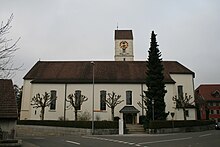Parish Church of St. Martin (Oberrohrdorf)
The parish church of St. Martin is the Roman Catholic parish church in Oberrohrdorf in the canton of Aargau in Switzerland . It is the main church of the Rohrdorf parish, which also includes the communities of Niederrohrdorf and Remetschwil . The church dedicated to Saint Martin of Tours dates back to the 11th century. Around 1640 a new baroque building was built, with the medieval church tower being retained. The church proved to be too small three centuries later, which is why it was demolished in 1939 and replaced by a much larger complex. The church tower, whose ground floor dates from the 14th century, has been preserved in its original condition.
history
The first church at the current location is likely to be a Romanesque hall church from the 11th century, which was 21.5 meters long and 8.5 meters wide. Earlier research was based on the founding of a church in the 9th century, but this can be traced back to the misinterpretation of a place name on a document from the St. Gallen monastery from the year 837. Whether the earliest verifiable church building had a wooden predecessor can only be guessed. The first unequivocal written evidence is an umbrella letter issued by Pope Hadrian IV of the Muri monastery , dated March 11, 1159. The parish extended over several villages and was essentially identical to the Rohrdorf office ; to it belonged Oberrohrdorf (with Staretschwil ), Niederrohrdorf (with Holzrüti and Vogelrüti), Remetschwil (with Busslingen and Sennhof), Bellikon (with Hausen), Künten (with Sulz), the Trostburger Twing (right-wing part of Mellingen ), Künten (with Sulz) and Stetten . The church patronage was held by the Alsatian monastery Murbach , the church tithing in Künten and Sulz was held by the monastery Muri .
In 1259 the Habsburgs took over the rights and property of the Murbach Monastery. Income and patronage rights were granted to the Lords of Rüssegg in the 13th century, and in 1344 to the Lords of Hünenberg. On September 21, 1413, Duke Friedrich IV sold the Rohrdorf church set to the Agness Hospital in Baden , which was founded by Agnes of Hungary . From then on, the city of Baden was entitled to appoint the pastor. When the Confederates conquered Aargau in 1415, ownership remained unchanged. Under the leadership of Pastor Heinrich Buchmann, the brother of Theodor Bibliander , the Rohrdorf parish converted to the Reformation in 1529 . Two years later, after the reformed places were defeated in the Second Kappel War , the population had to accept the old faith again. In 1638 the old church proved to be too small, which is why it was razed and replaced by a new building, which was completed in 1642. Stylistically, the building stood at the transition from the late Gothic to the early baroque . In 1652 the bones of the catacomb saint Castorius were transferred.
The parish bought back the church property from the city of Baden in 1826, but the city retained the right to appoint the pastor until 1872. The size of the parish decreased in several steps. In 1888 Stetten formed its own parish, in 1896 the former Trostburger Twing joined the Mellingen parish, in 1901 Künten separated and in 1925 Bellikon too . Despite the split off of the branches, the population of the core parish grew steadily. In 1938 the parish decided to demolish the church, which had again become too small, in order to rebuild it with a larger volume. Construction began in August 1939 and was completed in October 1940. In 1955 a new bell was purchased, from 1984 to 1987 extensive interior and exterior renovations were carried out.
Buildings and equipment
The new building from 1939/40 is unadorned, its external form primarily follows the principles of functionality and simplicity. Of the old church, only the church tower remained in its original condition, the foundation walls of which date from the 14th century. The floor plan corresponds to a classic country church with a nave and choir . The Basel architects Meyer & Gerster were responsible for planning the church . The avant-garde architecture of Switzerland at the time showed no interest in the Rohrdorfer Martinskirche. When a special edition of the architecture magazine “ Das Werk ” appeared in 1941 on Catholic church building, it was not mentioned in it.
The portal , altars , pulpit and crucifixion group of the previous building are integrated into the new building as protected fittings. The round arched portal from 1638/39 consists of a profiled sandstone frame and carved door leaves. The top sheet of the main altar and the paintings on the side altars are by Joseph Balmer (1877/78), two figures by Gregor Allhelg (1675). The Castorius relic can be found in the glazed base of the right altar structure.
literature
- Peter Hoegger: The art monuments of the canton of Aargau . Ed .: Society for Swiss Art History. Volume VI: District of Baden I. Birkhäuser Verlag, Basel 1976, ISBN 3-7643-0782-X , p. 436-439 .
- Fabian Furter, Martin Handschin, Bruno Meier , René Roca, Miriam Rorato: Rohrdorferberg - history of Oberrohrdorf, Niederrohrdorf and Remetschwil . 2011.
Web links
- Website of the parish of Rohrdorf
- Parish church of St. Martin (Oberrohrdorf) in the inventory of the canton of Aargau
Individual evidence
- ^ Furter et al .: Rohrdorferberg. Pp. 24-25.
- ^ Furter et al .: Rohrdorferberg. P. 28.
- ^ Furter et al .: Rohrdorferberg. Pp. 32-33.
- ^ Furter et al .: Rohrdorferberg. P. 49.
- ^ Furter et al .: Rohrdorferberg. P. 53.
- ^ Furter et al .: Rohrdorferberg. P. 58.
- ^ Furter et al .: Rohrdorferberg. Pp. 241-243.
- ^ Furter et al .: Rohrdorferberg. P. 242.
Coordinates: 47 ° 25 '8.6 " N , 8 ° 18' 53.6" E ; CH1903: 666125 / 252396


